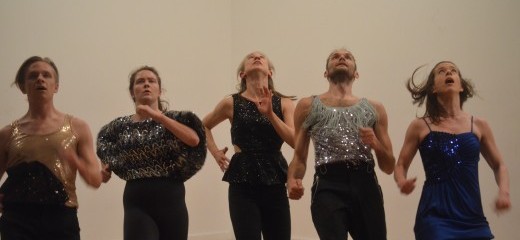
Photo: Robert J. Randall
How Do You Frame a Well-Made Dance?
by Annie Wilson
I have to start by saying that I watched this piece after a particularly traumatic week working in the restaurant industry. My nerves were frayed. I was exhausted. In that state, I found my way to the White Space in the Crane Arts building in Kensington, where the audience sat, listening to pre-show music, until it faded and choreographer Amy Lynne Barr came onstage to give the pre-show speech for her piece Back From Here. She started with general housekeeping (turn off your phones, the bathroom is over there, run time is about an hour), before segueing into an artistic statement.
Back From Here was inspired by her job as a server at the 4th Street Deli in Queens Village. As a way with coping with the monotony of the job, she would quantify. She counted the number of steps it took to get from the server station to a particular table. Every walking pattern in the restaurant she counted out by steps, noting how the number shifted depending on whether it was slow or busy. She told us how her imagination snuck into her job. What if she got creative with the steps? (And here she step-touches to demonstrate.) What if she had an ensemble of people accompan—
Bursting downstage, interrupting Barr’s curtain speech, an ensemble of dancers rush forward, singing:
HE WEARS A RED BANDANNA!
PLAYS A COOL PIANNAH!
IN A HONKY TONK
DOWN IN MEXICO
The group is made up of some of Philly’s finest—Beau Hancock, Ellie Goudie-Averill, Tori Lawrence, Ashley Lippolis, and Scott McPheeters.
This beginning satisfies the way an unexpected waterslide satisfies, the introduction slipping you into the piece with effortless momentum, until your butt leaves the plastic of the slide and you splash into cold water.
Bedecked in sequined costumes, each unique from the other, the cast sings the entirety of the song “Down in Mexico.” It’s the sort of song you liked, once, before you became a server. But now you hear it three times a shift, piped through the restaurant audio system. It’s catchy and inoffensive if you hear it once in a while, grating and depressing when you hear it too often. There are many songs like this.
More exciting than the song was watching each of the performers inhabit the act of singing the way servers might inhabit their jobs: some take to it like a fish to water, some hate it and overcompensate by getting super excited, some are uncomfortable but are doing it anyway because, hey—it’s their job. They are primarily dancers, not singers, just as Barr is a choreographer, not a server.
Now the piece slips into movement, and the dancers slip into the performative world they are masters at. The fourth wall gets thicker. And they dance.
Throughout the three movements: Dear You, Repetitive Body, and The Same, Barr weaves movement together seamlessly and masterfully. Dancers travel across the floor in phrases that rush, stop, disappear, and emerge again in a different pattern, only to fall apart. Barr clearly knows how to make dances. She knows how to use her cast to their strengths and how to hint at character through her vocabulary. The number of times I see Tori Lawrence lift in a passé, arms upstretched to heaven, evokes a different personage than Goudie-Averill’s swoop-sliding across the wood stage. The dance itself sings—its rhythm is melodic, the vocabulary both familiar and unexpected. The dance does something my favorite dances do: it seems to change the very physical structure of the space by the way the performers move through it. As the dancers lift, crawl over, and reach for each other, music by Sven Britt and Chopin fills the space between arms, legs, and torsos. Layered over the music was text by the artistic team, and most notably a poem by Inger Christensen:
A stone rolls down from the mountains
Sisyphus pushes it up
A stone rolls down from the mountains
Sisyphus pushes it up
A stone rolls down from the mountains
Sisyphus pushes it up
Sisyphus sings:
A stone flies up over the mountains”
The piece ends the way it begins: with a reprise of “Down in Mexico.” The use of bookends was disappointing—weirdly predictable and surprising.
Which leads me to wonder about the framing of the piece. I loved the conceptual kick it started with. Yet, I wonder why Barr specifically contextualized a dance that is interested in rhythm, repetition, luscious and full-bodied movement, and thematic vocabulary that hints at character as referencing the service industry? The piece itself is much more abstract and could very well be about the laundry pile that never diminishes, the thirst that can’t be quenched, the rent that needs to be paid, the breath that insists on being taken every couple seconds without fail. Perhaps that was the point, to take a specific experience and open it up to be universal. Perhaps I was too traumatized by my past week of restaurant work to be able to see it correctly. But if it did open us to the universal, why return to the song? So I wonder—did the frame of the dance do the dance inside justice?
And yet, that song does have staying power—even after a couple weeks. I think back to the piece and I see and hear Scott McPheeters, asymmetrical haircut and sequined shirt, belting:
HE WEARS A PURPLE SASH
AND A BLACK MUSTACHE
IN A HONKY TONK
DOWN IN MEXICO….
By Annie Wilson
June 3, 2014

